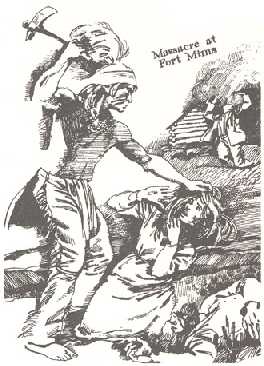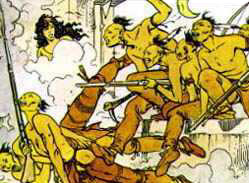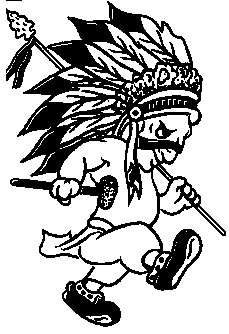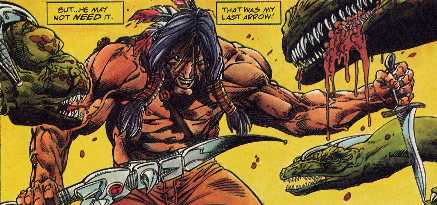

 Another Stereotype of the Month entry:
Another Stereotype of the Month entry:


 Another Stereotype of the Month entry:
Another Stereotype of the Month entry:
American Indians in Illinois country
By Bill Nunes
Wednesday, June 6, 2007 8:25 AM CDT
The ancestors of the Indians in Illinois first arrived here thousands of years ago from Northeastern Asia. They came across a land bridge that existed at what is now called the Bering Strait.
They had coarse black hair, beardless faces, copper-colored bodies that suggested Mongoloid ancestry. Yet their eyes were round, more like Europeans. At the time of the arrival of the first whites, the land had a confederacy which consisted the Peoria, Kaskaskia, Cahokia, Kickapoo, Michigamea and the Tamaroa. The Peoria were to be mainly found near Lake Pimiteau (Peoria) on the Illinois River. The Cahokia and Tamaroa lived on the American Bottom. The fierce Kickapoo lived in the Sangamon River valley and Mackinaw River valley.
The name Illinois was derived from the word "Illini," meaning a complete and superior man. The first Frenchmen were greeted by natives who pounded their chests and with characteristic boldness uttered the word which told the newcomers, "See what fine men we are, accomplished and full of vigor and strength." This, of course, is the reason the University of Illinois marching band and sports teams took the name "Fighting Illini," imagining themselves to be superior to their rivals. If you're wondering why something as tame as a marching band had the audacity to think themselves superior, it's because the great John Philip Sousa once called the Illinois marching band the best in the entire country.
The plural form of the name that the tribesmen gave themselves was Illiniwek. It proved much too difficult for the tongues of the French, so they softened it by adding their own ending — Le Pays des Illinois, the country of the Illinois.
When the French first came into the area they mostly learned to live in peace with their neighbors. The French did not depict the natives as a murderous heathen, nor did they sentimentalize them in poems that called them noble savages. They lived comfortably among the natives and even mated casually with them. Indian women were attractive and made good wives due to their household and child-rearing skills. The Illini were handsome creatures. According to Sieur de Leitte, their legs seemed to be "drawn by an artist's pen." They "moved under a load of wood as gracefully as a dancer." They had the "whitest teeth" imaginable. They were lively and intelligent and were good hunters and good runners. He also noted their faults. They were "vain, licentious, and hypercritical." The men among them had a reckless passion for gambling that often led to ruin. They punished unfaithful wives by cutting off their noses and sold their spouses and sisters for mere trinkets. Marquette and Joliet were surprised to discover that the Indians tortured their enemies, tattooed their bodies, captured other tribesmen and practiced slavery, and also ate dog meat. Their only clothes were animal skins. The men made little effort to cover themselves, but the women were usually modestly dressed. Leitte's recorded impressions were backed by journals of all the French explorers who mostly professed admiration for the Illiniwek.
The men wooed potential brides by carrying to her parent's tepee presents of gourds, kettles, guns, skins and possibly a slave, declaring that it was only at her fire that he wished to warm himself. Often this was not enough, and the suitor was forced to bring yet more presents. At no time during the negotiations was the maiden allowed to look at the young brave, for that indicated a lack of modesty. The men were the hunters and protectors while the women grew crops, took care of the children, made pottery and clothing, and cooked the meals. Indian women had one big advantage over pioneer white women. They lived in huts that were within 15 or 20 feet of their neighbor, so they performed most of their chores in close association with other squaws. They did not have to suffer the bitter loneliness so often mentioned in diaries of whites.
Most of the early French traders and trappers took Indian squaws for wives. The word squaw comes from the Algonquin for woman. White women were scarce in the harsh and dangerous environment of New France. Indian women made attractive wives for several reasons. First, they were already skilled in survival and had cooking and sewing skills to make life more pleasant for her husband. Second, marrying an Indian maiden afforded protection when the Indians went on the warpath. Frenchmen with Indian wives were usually left alone by warring braves.
Squaws usually returned to their work within a week of giving birth. Their task was made easier by the use of a papoose board or cradle that was strapped to her back, giving her the freedom to do other things. Strangely, white women never adopted this practical device in large numbers. While adultery was sometimes committed by squaws, the punishment was much harsher than the wearing of a scarlet letter A. In some cases, the woman was taken to the middle of the village and offered to any and all braves who wanted her. Prostitution, as we know it in the western world, simply did not exist among the Indians.
As a whole, Indians did not treat their wives in the romantic notion of today's standards. She was more of a baby factory and a beast of burden. Half-breed children were plentiful, especially during the early French regime. Many whites did not legally marry their Indian wives and were free to take white ones when they became available.
The Illinois Indians did not bury their dead. They placed the body in the branches of a tree until the flesh rotted away. Then the bones were gathered up and placed in a sepulcher. The ceremonies attending death were equally rich in drama. If the dead man had been a warrior, he was celebrated with a great dance with different movements representing his various achievements. If his passion had been the game of lacrosse, a great contest was staged to honor his memory.
As might be expected, the Illiniwek were a superstitious lot. If an expectant mother had difficulty during delivery and cried out in pain, the young men of the village would gather around her lodge and utter horrific screams and beat on the lodge with sticks to drive the evil spirits away.
It was not pleasant to be captured in battle by the fierce Illiniwek. According to a memoir written by Henri Tonty's nephew, captured enemy males were tortured, disemboweled and their hearts eaten raw. Mothers dipped the feet of their young male children into the blood of the deceased's thoracic cavity. The Illiniwek were cruel toward their enemies and they were often killed by fire. The prisoner was tied to a tree and dried grass and twigs were placed at his feet. Torches of straw were applied to the body. Sometimes it took up to six hours before the prisoner expired. It was not unusual for the task of torture to be left to the women of the tribe.
There was one occasion where a particularly brave warrior cried out in contempt at the lack of sadistic expertise by his captors.
"You know nothing of torture," he spat from his lips. Stung by his taunt, one of the women gouged out his eyes to correct his judgment. "Yes," he said, "that is real torture."
Bill Nunes, a Glen Carbon resident, is author of "Southern Illinois: An Illustrated History" and 11 other books.
A Native replies
Cahokia Mounds State Historical Site
As you can see from this web page, the ancestors of all Illinois Indians were a savage, scruffy lot indeed. They lived in huts, crowed into a city with typical urban troubles, wasted their time builing a series of mounds, included one that took years of time they couls have used to farm.
OR
They constructed more than 120 earthen mounds over an area of six square miles, although only 80 survive today. These industrious people moved over an estimated 55 million cubic feet of earth in woven baskets to create this network of mounds and community plazas. Monks Mound, for example, covers 14 acres, rises 100 feet, and was topped by a massive 5,000 square-foot building another 50 feet high. As the largest prehistoric earthen construction in the Americas, Monks Mound is a testament to the sophisticated engineering skills of these people.
It's all in how you write it. Your article is an example of how to writew prejudice while trying to look fair and balanced. Whoever wrote this must watcha lot of Fox News TV.
Linde [Knighton]



Rob's reply
Nunes's piece is rife with assumptions, stereotypes, and slanted reporting. Even if the details are accurate, the total picture is prejudiced against Indians. Here are some examples:
>> They came across a land bridge that existed at what is now called the Bering Strait. <<
Many Native people would say they've always lived on the American continent. Scientifically speaking, the Bering Strait theory has little substantiation so far. The alternative is that people came over by boat.
>> They had coarse black hair, beardless faces, copper-colored bodies that suggested Mongoloid ancestry. <<
Since people know what Indians look like, this comment is gratuitous. It serves to make Indians seem foreign and exotic—i.e., different from and less than the Anglo-Saxon norm.
>> The name Illinois was derived from the word "Illini," meaning a complete and superior man. <<
Here's what the Plummer report said on the meaning of "Illini":
Seeking a Compromise — Chief Illiniwek
A Report by Trustee Roger Plummer to the University of Illinois Board of Trustees
March 13 — 14, 2002
Illini is but another form of the Indian word Illinois, and has the same meaning, i.e. 'real men.'
While this may imply superiority, it doesn't state it directly. Nunes has built a house of cards on the assumption that the Illini considered themselves superior and fought to maintain their status.
>> The first Frenchmen were greeted by natives who pounded their chests and with characteristic boldness uttered the word which told the newcomers, "See what fine men we are, accomplished and full of vigor and strength." <<
I doubt the Indians literally pounded their chests. The interpretation of the so-called word is Nunes's speculation, not historical fact.
>> This, of course, is the reason the University of Illinois marching band and sports teams took the name "Fighting Illini," imagining themselves to be superior to their rivals. <<
Thinking oneself superior has little or nothing to do with fighting others. Perhaps the Illini considered themselves so superior that they didn't need to fight their inferiors. A Muhammad Ali type doesn't go around picking fights with people, after all. He has no need to lower himself to their level, to soil his hands with them.
Nunes is buying into the stereotype the University of Illinois used to justify its Chief Illiniwek mascot. Namely, that all or most Indians were fighters.
See Indians as Warriors for more on the subject.
>> This, of course, is the reason the University of Illinois marching band and sports teams took the name "Fighting Illini," imagining themselves to be superior to their rivals. <<
In other words, they imagined themselves to be fierce, savage, and warlike.
>> The Illini were handsome creatures. <<
Think about the implications of the word "creatures." (I'll spell them out later.)
In this paragraph and throughout his essay, Nunes concentrates on the Illini's negative aspects. He doesn't try or want to present a balanced picture. His goal is to paint the people as fierce, savage, and warlike so he can justify the "Fighting Illini" nickname.

Indians dressed like animals?
>> Their only clothes were animal skins. <<
So what? If they were well sewn, they'd be as warm and comfortable as any other kind of clothing. Again, Nunes implies how primitive and beastlike the Indians were.
>> The men made little effort to cover themselves, but the women were usually modestly dressed. <<
If it was warm outside, why should they make an effort to cover themselves? Does Nunes think they intentionally froze? This is pure Eurocentric bias.
>> The men wooed potential brides by carrying to her parent's tepee presents of gourds, kettles, guns, skins and possibly a slave, declaring that it was only at her fire that he wished to warm himself. <<
Indians didn't have metal kettles or guns when they first met the Europeans. Nunes may be cherry-picking facts from different eras.
>> They lived in huts that were within 15 or 20 feet of their neighbor, so they performed most of their chores in close association with other squaws. <<
Nunes doesn't know or care that most Indians consider "squaw" pejorative. His continued use of the word shows his ignorance.
As one settler wrote: "It was customary [for the whites] to speak of the Indian man as a buck; of the woman as a squaw; until at length in the general acceptance of the terms, they ceased to recognize the rights of humanity in those to whom they were applied. By a very natural and easy transition, from being spoken of as brutes, they came to be thought of as game to be shot, or as vermin to be destroyed."
See Squelching the S-Word for more on the subject.
>> Second, marrying an Indian maiden afforded protection when the Indians went on the warpath. Frenchmen with Indian wives were usually left alone by warring braves. <<
"Warpath" and "braves"...stereotype alert!
>> As a whole, Indians did not treat their wives in the romantic notion of today's standards. She was more of a baby factory and a beast of burden. <<
Why generalize about this point when the essay is supposedly about the Illini? Because it's another chance to score points against Indians.
Actually, Indians treated women in a variety of ways. Many tribes honored women and relied on their counsel—most famously in the Haudenosaunee League. As a whole, I'd say Indian women were better off than their Western counterparts.
Here are a few quotes on the subject:
Everyone had a hand in the harvesting and preserving of food, while the best hunters and fishermen, and probably the most skilled observers and preparers of food, had added status in the communities. And after these seasonal subsistence activities which seemed to have been considered easy, almost holiday time for the people, like a prolonged picnic, came the serious activities. It meant everyone was not only encouraged to display his abilities, but required to do so. It would seem that all men practised all the men's trades and arts—boatbuilding, carpentry, tool-, weapon-, utensil-, vessel-making, and so on, as well as painting and carving ceremonial objects, as all the women were preparers of food, weavers, basket-makers and so on, and all were singers and dancers, actors in the ritual drams which were such a part of the winter ceremonies.
Bill Reid (Haida), describing his traditional culture, in the book Bill Reid by Doris Shadbolt
Columbus and his successors were not coming into an empty wilderness, but into a world which in some places was as densely populated as Europe itself, where the culture was complex, where human relations were more egalitarian than in Europe, and where the relations among men, women, children, and nature were more beautifully worked out than perhaps any place in the world.
Howard Zinn, A People's History of the United States 1492—Present, Chapter 1, Columbus, the Indians, and Human Progress
>> The Illinois Indians did not bury their dead. They placed the body in the branches of a tree until the flesh rotted away. <<
More of Nunes's biased focus on what he considers negative and primitive.
Who says burying one's dead is the most "civilized" method of disposal? Today people are increasingly having their bodies cremated. Does that mean our parents and grandparents were less civilized than we are?
No, it means we're increasingly aware of the limited space on our planet and the need to recycle everything, including ourselves. Cremating bodies or letting them rot into nothingness is arguably more smart and thoughtful--hence civilized--than buring them.
Incidentally, since Nunes is talking about Indians' burial customs, why not talk about their origin myths or belief in a creator? Because that would make the Indians seem more sophisticated and civilized.

Indians a "superstitious lot"?
>> As might be expected, the Illiniwek were a superstitious lot. <<
This is perhaps the most biased and stereotypical claim in the essay. It's funny considering Europeans were talking about "humours" and bleeding sick people to death at the time. I don't know much about the history of Western medicine, but I'm sure it was chockful of ignorant and superstitious beliefs. (Any Judeo-Christian prayer for succor is just as superstitious, as far as I'm concerned.)
In contrast, Indians were known for their medical skills. They were accomplished at developing cures, performing surgeries, and healing patients holistically. Jack Weatherford covered this subject in his excellent book Indian Givers.
For more on how rational or superstitious Indians were, see Ten Lies about Indigenous Science – How to Talk Back and "Primitive" Indian Religion.
>> If an expectant mother had difficulty during delivery and cried out in pain, the young men of the village would gather around her lodge and utter horrific screams and beat on the lodge with sticks to drive the evil spirits away. <<
More emphasis on the negative and primitive.
Even if this were true, the real question is whether it worked. One could posit that the screaming and beating had a psychosomatic effect on the patient, so it's not out of the question. Perhaps it was enough to distract her from the pain—to make her forget it for awhile.
>> It was not pleasant to be captured in battle by the fierce Illiniwek. <<
Still more emphasis on the negative and primitive.
>> According to a memoir written by Henri Tonty's nephew, captured enemy males were tortured, disemboweled and their hearts eaten raw. <<
Any report of cannibalism should be considered suspect. Europeans had every reason to invent or exaggerate Native practices to make them look bad.
See Indians as Cannibals for more on the subject.
>> "You know nothing of torture," he spat from his lips. Stung by his taunt, one of the women gouged out his eyes to correct his judgment. "Yes," he said, "that is real torture." <<
Nunes finishes his essay with a gut-wrenching scene of torture. This is the image he wants us to go away with. The Illini were terribly fierce, savage, and warlike. No wonder the University of Illinois chose to use the Fighting Illini name.
Of course, it raises the question of whether the sports teams know they're associating themselves with torturers and slavers. Maybe this could inspire some slogans for them: "We'll gouge out your eyes to win a game." "Fight on for Abu Ghraib!"
Overall, Nunes's essay is about 75% negative and 25% positive. He says little or nothing about the Illini's beliefs, values, arts, or sciences. It's mainly about warfare, enslavement, and torture.
Linde Knighton picked up on this bias too. Nunes slanted his piece to disparage Indians. He included the most defamatory material and excluded any exculpatory material.
As Knighton noted, the ancestors of the Illini built huge mounds that required complex engineering and management skills. Where is that information in Nunes's write-up? Nowhere, of course, because that would make the Illini look good.
It gets worse. When Nunes writes:
They "moved under a load of wood as gracefully as a dancer." They had the "whitest teeth" imaginable. They were lively and intelligent and were good hunters and good runners.
he's essentially comparing the Illini to animals. He even calls them "handsome creatures." Try calling the pope or president a "handsome creature" and see if anyone praises you.
According to Nunes, the Illini were fierce, savage, and warlike just like other predatory beasts. They dressed like animals, looked like animals, and acted like animals. Therefore, we can ignore their accomplishments and appropriate their names for our sports teams.
Related links
Scalping, torture, and mutilation by Indians
Uncivilized Indians
Savage Indians
Team names and mascots
|
. . . |

|
All material © copyright its original owners, except where noted.
Original text and pictures © copyright 2007 by Robert Schmidt.
Copyrighted material is posted under the Fair Use provision of the Copyright Act,
which allows copying for nonprofit educational uses including criticism and commentary.
Comments sent to the publisher become the property of Blue Corn Comics
and may be used in other postings without permission.